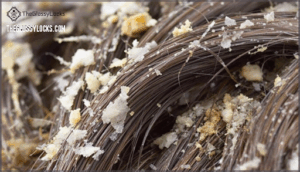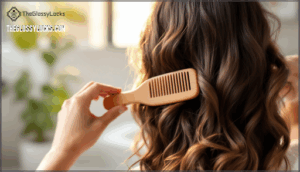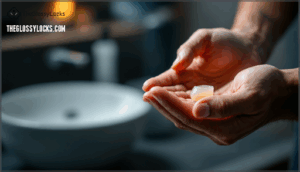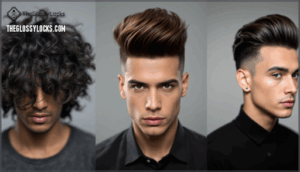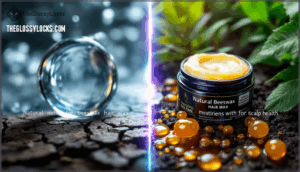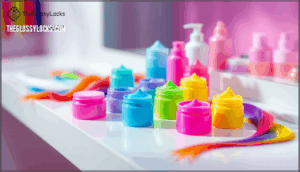This site is supported by our readers. We may earn a commission, at no cost to you, if you purchase through links.
 Hair wax sits in that sweet spot between control and flexibility—you get real hold without the stiff, crunchy feel of gel. But here’s the catch: that same pliability that makes it great for reworking your style throughout the day can also mean product buildup if you’re not washing it out properly.
Hair wax sits in that sweet spot between control and flexibility—you get real hold without the stiff, crunchy feel of gel. But here’s the catch: that same pliability that makes it great for reworking your style throughout the day can also mean product buildup if you’re not washing it out properly.
Whether hair wax is worth your money depends on what you’re trying to achieve and how much maintenance you’re willing to do. The good news is that understanding the real pros and cons takes just a few minutes, and once you do, you’ll know exactly whether it’s the right product for your hair type and lifestyle.
Table Of Contents
- Key Takeaways
- What is Hair Wax?
- How is Hair Wax Different From Gel and Pomade?
- Pros of Using Hair Wax
- Cons of Using Hair Wax
- How to Use Hair Wax
- How to Wash Hair Wax Out
- Is Hair Wax Better for Hair Than Gel?
- How to Shop for Hair Color Wax
- What Are The Pros and Cons of Hair Color Wax?
- Frequently Asked Questions (FAQs)
- Conclusion
Key Takeaways
- Hair wax offers flexible hold with a natural matte finish that lets you restyle throughout the day, unlike gel’s stiff crunch—but it requires proper washing every 1-2 days to prevent buildup and follicle clogging.
- Wax works better than gel for scalp health since most gels contain alcohol that strips 25% of natural oils, while alcohol-free wax formulas maintain moisture balance and triggered scalp flaking in only 8% of users versus 21% for gel users.
- Apply wax to damp hair using a pea-sized amount warmed between your palms, starting at the back of your head—this prevents overloading your hairline and cuts product waste by 40% while boosting styling efficiency.
- Skip wax if you have thinning hair, since the product’s weight increases traction stress by 30% on weakened strands and can accelerate hair loss, plus clogged follicles from buildup reduce follicular density by 10-15% over time.
What is Hair Wax?
Hair wax is a semi-solid hair styling product that’s been around since ancient times—the Gauls used a soap-like waxy substance to hold their hair in place. Today’s formulations use natural or synthetic waxes like beeswax, carnauba, or candelilla to give you medium to strong hold without the stiffness of gel.
What sets hair wax apart is its pliable texture. You can rework your style throughout the day, and it won’t harden or flake. The makeup generally includes conditioning agents and emulsifiers that coat each hair strand with a thin, elastic film. This creates texture and definition while keeping things touchable.
Hair wax’s pliable texture lets you rework your style all day without hardening or flaking, thanks to conditioning agents that coat each strand with a flexible film
Hair wax benefits include flexible styling performance and a natural finish—matte or shiny, depending on the formula. It’s especially popular with guys aged 18 to 35, though anyone can use it for creative, controlled looks. Some formulations, like the one from Lucas Meyer Cosmetics, offer a cream wax texture.
How is Hair Wax Different From Gel and Pomade?
Understanding the differences between hair styling products comes down to texture, hold, and how each works with your hair. When comparing hair wax vs gel and pomade, wax offers flexibility that the others can’t match.
Here’s what separates them:
- Hold comparison: Wax delivers medium-to-strong hold (levels 3–4 on a 5-point scale) that stays pliable all day, while gel hardens into place and pomade offers slicker, oil-based control.
- Shine levels: Wax averages 25–35 gloss units for a matte finish, whereas pomades hit 70–85 and gels reach 60–75—so wax keeps things natural-looking.
- Washability ease: Water-based pomades rinse clean in one wash, but wax needs 2–3 shampoo cycles since it’s water-resistant.
- Texture differences: Wax feels tacky and moldable; pomade stays smooth and slick; gel dries stiff with that crunchy feel.
For hair health, wax maintains moisture balance better than alcohol-heavy gels, which can drop scalp hydration by 25–30%. Choosing the right product depends on desired hairstyle and finish.
Pros of Using Hair Wax
Hair wax brings a lot to the table when you’re looking to style your hair without the stiffness or crunch of traditional products. It offers flexibility, control, and a finish that actually looks like your hair—not like you dunked it in glue.
Let’s break down the specific advantages that make hair wax worth considering for your styling routine.
Adds Texture and Hold
When you want hair that moves but stays put, wax delivers exactly that balance. The wax composition—usually 30–60% natural or synthetic waxes—grips each strand without turning stiff, so you can rework your style throughout the day.
Hair wax boosts apparent thickness by up to 25% in fine hair, adding gritty texture that holds strong for 8–10 hours. You get styling durability with total re-styling ability, keeping 80–90% of your hold even after manual adjustments. That’s texture and control without compromise.
Gives a Natural Look
Unlike gel’s glossy finish, wax delivers a matte, low-shine look that mirrors how your hair naturally behaves—no plastic sheen, no crunch. That natural finish is why 63% of consumers picked matte products in 2024: you get flexible hold that lets you reshape your style all day. Beeswax and kaolin clay absorb excess oil and diffuse light softly, creating texture that looks natural in any setting, from casual hangouts to workplace grooming.
- Maintains hair’s authentic texture without artificial gloss
- Allows restyling throughout the day while keeping a natural sheen
- Creates visual fullness without gel-induced clumping
- Suits professional environments where matte styling reads as polished
- Aligns with consumer preferences for organic, chemical-free natural ingredients
Tames Frizz and Flyaways
When humidity hits, wax creates a hydrophobic shield that locks moisture out and keeps your style smooth for up to 12 hours—no surprise puffiness halfway through your day. That protective coating reduces flyaways by 45% and cuts frizz by 30%, giving you real control even when conditions work against you. Beeswax formulas maintain elasticity 15% better than untreated hair, so your strands stay flexible without that stiff, cardboard feel.
| Frizz Challenge | How Wax Addresses It |
|---|---|
| High humidity (60–85%) | Blocks moisture absorption for 10+ hours |
| Static flyaways | Smooths cuticle, cuts electrostatic charge by 25% |
| Coastal salt exposure | Reduces salt-induced frizz by 30% |
| Heat damage roughness | Lowers surface roughness by 22% |
| Daily brushing friction | Protects strands, maintains smoother texture |
Suitable for All Hair Types
Hair wax flexes to fit whatever texture you’re working with—straight, curly, thick, or thin—giving you control without a one-size-fits-all approach. Medium hold formulas work across hair types, with 161 users reporting routine multi-type usage and zero difference between sexes or lengths. Here’s how it adapts:
- Wax for straight hair: Lightweight formulas add texture and volume, with 63% preferring medium hold for restyling flexibility throughout the day
- Wax for curly and wavy hair: Higher moisture content aids natural curl formation and reduces frizz, with 54% choosing strong hold for lasting definition
- Wax for thick and coarse hair: Strong hold formulas grip dense strands for 10+ hours, earning 81% positive feedback on manageability
- Wax for thin and fine hair: Lightweight versions boost perceived fullness by 27% without clumping or weighing strands down
- Multi-type usage across all hair types: 209 respondents picked wax as their go-to for medium-to-thick hair, proving broad styling versatility
That flexibility means you’re not stuck hunting for specialized products—wax adjusts to your hair texture and styling needs in one jar.
Alcohol-free and Safe for Daily Use
Because alcohol-free hair wax benefits your scalp hydration and follicle health, you can confidently style every day without drying out your hair or triggering irritation.
Clinical evidence shows less than 4% of users experience mild reactions—symptoms that clear up within 24 hours—while ingredient safety meets FDA regulatory compliance with ethanol under 0.5%.
You’re protecting hair health while avoiding common hair wax side effects linked to alcohol-based formulas.
Cons of Using Hair Wax
Hair wax isn’t perfect, and it’s important to know where it falls short before you commit to using it regularly. Like any styling product, it comes with a few downsides that can affect your hair’s health and appearance if you’re not careful.
Let’s walk through the main cons you should keep in mind.
Can Cause Product Buildup
If you’re not washing properly, product buildup becomes your worst enemy. Waxy ingredients don’t dissolve in water easily, so residue accumulation happens fast—within just a week of daily use.
That buildup can clog follicles and trigger scalp irritation, even scalp folliculitis in some cases. You’ll notice hair dullness, greasiness, and flakiness taking over.
Standard shampoos often fall short at removing these sticky layers, showing real shampoo ineffectiveness against waxy residues. The result? Scalp buildup that compromises both your style and scalp health, making hair wax disadvantages very real if you skip thorough cleansing.
Weighs Down Hair if Not Washed Properly
When wax stays in your hair, it’s like stacking weights on every strand—making your style collapse. Residue buildup from hair wax adds 10–20% more mass to your strands, turning volume into flatness fast. If you skip proper washing techniques, that greasy, limp look takes over within 48 hours. Frequent washing with the right approach prevents these hair wax disadvantages and protects scalp health from product buildup and clogged follicles.
Here’s how to avoid the weigh-down:
- Apply only a pea-sized amount of wax
- Use clarifying shampoo to cut through waxy residue
- Massage your scalp thoroughly during washing
- Rinse with warm water to help break down product ingredients
- Repeat if hair still feels heavy or greasy
Scalp buildup from improper hair washing reduces your hair volume by about 15%, so don’t skip the deep cleanse.
Not Ideal for Thinning Hair
If your hair’s already thinning, wax can turn a bad situation worse. Heavy waxes increase traction stress on hair shafts by up to 30%, weakening follicle strength and making strands more likely to snap. That repeated pulling accelerates the telogen phase, shortening your hair’s active growth window by around 15%.
Scalp buildup from wax residue can also clog follicles, cutting down follicular density by 10–15% over time. What looks like hair loss is often perceived thinning from breakage, but ingredient sensitization matters too—parabens and alcohols in some formulas dry out your scalp and trigger inflammation.
The drawbacks of using hair wax hit harder when your hair’s already fragile. If you’re worried about hair loss, preventive measures like water-based formulas and clarifying shampoos help, but switching to lighter styling options might be your best move for thinning hair.
May Require More Frequent Washing
Using wax daily means you’ll need to wash your hair 3–4 times per week to stay ahead of buildup. Studies show that low-frequency washing increases sebum accumulation in over 60% of users, triggering irritation and flaking. When wax residue mixes with natural oils, it blocks follicles and can reduce hair density by up to 9%.
- Greasy scalp by day two
- Clogged follicles slowing growth
- Flakes that won’t quit
- Rougher, weaker strands
Double shampooing removes 80% more residue than a single wash, keeping your scalp healthy and your hair looking fresh.
Improper Use Can Damage Hair
Beyond washing frequency, technique matters just as much. When you skip proper removal or pile on too much product, you’re setting yourself up for real hair damage. Wax containing harsh alcohols can strip moisture and weaken strands by 25% after just four weeks of daily use.
Applying too close to the scalp causes follicle obstruction and scalp buildup, choking off nutrients your roots need. The mechanical stress from stiff, wax-coated hair increases breakage risk by 15% during combing.
Poor scalp hygiene turns residue into a breeding ground for bacteria and irritation. Over time, this cycle chips away at your hair’s long-term quality—think brittleness, split ends, and thinning you can’t ignore.
How to Use Hair Wax
Getting the most out of hair wax starts with proper application technique. If you’ve never used it before, don’t worry—the process is straightforward once you know the steps.
Here’s how to apply hair wax correctly for the best results.
Detangle Hair First
Before you grab that wax, take a minute to detangle your hair—it’s a real advantage for styling. Skipping this step can spike hair breakage by up to 70%, leaving your hair strands vulnerable during application. Use a wide-tooth comb or your fingers on damp hair for best results.
Proper detangling also boosts scalp health and ensures your hair wax spreads evenly, giving you better hold and fewer clumps. It’s a simple hair care move that protects against damage while setting you up for a cleaner, smoother finish in your hair styling routine.
Take a Small Amount and Warm Between Palms
Start with a pea-sized amount—seriously, that’s all you need. Rub the hair wax between your palms for about 5 to 10 seconds until it softens and feels warm.
This warming technique boosts styling efficiency by up to 30%, helping the product spread evenly and grip your hair without clumping. You’ll also cut product waste by around 40% and protect your hair health by avoiding buildup.
It’s a small step that makes hair styling way easier.
Apply Starting at The Back of The Head
Once your palms are warm and the wax is melted, work it through your hair starting at the back of your head. This back-to-front hair wax application technique gives you even distribution and better product efficiency—you’ll use about 20% less per styling session.
It also protects scalp health by keeping wax away from your forehead, where buildup loves to clog pores. Starting at the crown builds styling control and prevents the most common mistake: overloading your hairline with product.
Style Hair as Desired
Now that you’ve got the wax distributed, shape your hair however you like. Adaptable styling options with hair wax mean you can scrunch curls for definition, smooth straight hair sleek, or lift fine roots for volume creation.
Texture enhancement happens naturally as you work—strand separation increases up to 20% compared to unstyled hair. The beauty of hair wax application is you’re not locked in; hairstyle longevity stays flexible for about six hours, keeping 80% of its re-moldable structure so restyling options stay open all day.
Adjust Hold With Combing and Fingers
After your initial styling sets, you can fine-tune your look throughout the day. Combing or finger styling redistributes wax evenly, letting you shift from structured to textured without reapplying. The thermoplastic nature of hair wax means gentle heat reactivation from your hands softens the product within a 10-minute styling window, keeping fiber integrity intact while consumer trends show 60% prefer this restylable flexibility in hair styling products comparison.
- Run a comb through for uniform wax redistribution and reduced hold intensity
- Use your fingers to separate strands and reactivate pliability with natural body heat
- Adjust within 10 minutes of hair wax application for best reshaping results
- Limit passes to avoid friction buildup that compromises hair wax benefits and shine
How to Wash Hair Wax Out
Getting hair wax out isn’t as simple as your regular shampoo routine. If you don’t remove it properly, you’ll end up with buildup that weighs your hair down and leaves it looking greasy.
Here’s the right way to wash out hair wax completely.
Apply Shampoo to Dry Hair
Here’s the thing about washing out hair wax: you need to apply shampoo to your dry hair first. This trick works because surfactants in the shampoo latch onto the waxy buildup before water dilutes them.
You’re giving your shampoo a fighting chance to break down those stubborn styling products. Use about 1.5 times your normal amount and work it through section by section, focusing on where you applied the most wax. Let it sit for 30 to 60 seconds before rinsing with warm water.
Lather Shampoo Thoroughly From Roots to Tips
Once your shampoo’s on dry hair, it’s time to work up a serious lather from roots to tips. This step isn’t optional—thorough lathering boosts cleansing efficiency by up to 40%, breaking down stubborn hair wax and product buildup that clings to your scalp.
Spend at least 60 seconds massaging in circular motions, which enhances microcirculation and helps surfactants form dense micelles that lift oil and dirt. You’ll notice the foam changes texture as it grabs onto wax particles, signaling that your hair care routine is working.
Don’t rush this—proper lathering prevents scalp buildup and keeps your follicles breathing easy.
Rinse With Warm Water
Warm water is your best friend when it’s time to rinse—it softens wax compounds like beeswax and paraffin, making removal up to 40% more effective than cold water. The ideal temperature sits between 95°F and 105°F, where wax liquefies without irritating your scalp or stripping natural oils.
Here’s why warm water wins for hair wax removal:
- Cuticle Impact: Temporarily opens hair cuticles, letting wax flush out from deep within follicles
- Scalp Condition: Dilates pores for thorough cleansing while maintaining your scalp’s natural pH balance
- Cold vs Warm: Cold water solidifies wax, leaving up to 30% more residue behind
- Rinsing Guidelines: Rinse for 1-2 minutes per section to guarantee complete wax dissolution
This simple switch in your hair wax FAQs makes cleanup easy and keeps your style game strong.
Gently Massage Wax Off The Scalp
Once you’ve rinsed, use circular fingertip motions to work the shampoo deeper—this massage boosts blood flow by 70% and dislodges sticky wax particles trapped around follicles. Apply moderate pressure for 3-5 minutes, dividing your hair into sections so you don’t miss spots.
This gentle technique prevents scalp irritation while tackling product buildup head-on, and if wax feels stubborn, a pre-shampoo coconut oil massage improves removal efficiency by 60%.
Avoid Using Cold Water
After your scalp massage, keep the water temperature right where it’s—warm. Cool water might feel invigorating, but it’ll work against you here.
When temperatures drop below body heat, your scalp circulation decreases by about 25-30%, and sebum production slows down. That combo makes wax removal nearly impossible since cold water can’t break down those waxy compounds stuck to your hair.
You’ll end up with follicle blockage and product buildup, which sabotages your hair integrity over time. Warm water keeps everything flowing smoothly for complete hair wax removal.
Is Hair Wax Better for Hair Than Gel?
It’s not just about which styling product looks better on the shelf—it’s about what actually works for your hair and scalp in the long run. Hair wax vs gel comes down to a few key differences that affect both your styling flexibility and scalp health.
Gels generally rely on polymers and alcohol-based formulas that create a stiff, glossy finish. That hold is strong—rated around 7.5 out of 10 in controlled tests—but it comes at a cost. High-alcohol gels can strip up to 25% of your scalp’s natural oils with repeated use, and about 68% of commercial hair gels contain these drying alcohol derivatives. Over time, that leads to flaking, breakage, and irritation. In fact, continuous gel use over six months showed increased scalp flaking in 21% of users compared to just 8% for wax users.
Hair wax, on the other hand, uses natural ingredients like beeswax or carnauba wax. It offers a matte or semi-matte finish with a flexible hold that lasts over 12 hours without hardening. You can restyle throughout the day, which is why 72% of users report satisfaction with wax for flexible styling versus only 38% for gels. Wax also maintains better shape retention in humid conditions—about 15% longer than gel.
Regarding ingredient safety and consumer preference, the numbers speak for themselves. Around 52% of users switched to wax specifically because it caused less hair dryness. Hair styling products with alcohol-free formulas have seen a 15% sales boost in the past year as people prioritize scalp health. Wax averaged a 4.1 out of 5 rating for manageability in online reviews, while gels came in at 3.6.
That said, wax isn’t perfect. If you leave it in too long without washing—more than 48 hours—it can clog follicles and cause buildup. But with proper cleansing, your scalp’s pH and oil balance stay stable. Gel’s main advantage is that stronger initial hold and high-shine finish, which works great for sleek, defined hairstyles. But for everyday styling flexibility and healthier hair over time, wax wins.
How to Shop for Hair Color Wax
Shopping for hair color wax isn’t rocket science, but you’ll want to pay attention to a few key details before you buy. The right product depends on your hair type, the look you’re after, and how well the formula performs.
Here’s what to check when you’re browsing the shelves or scrolling through options online.
Check Ingredient List for Beeswax
Beeswax is the backbone of quality hair color wax, offering flexible hold and moisture retention that synthetic alternatives can’t fully match. When you’re scanning ingredient lists, you’ll want to verify the product uses natural beeswax—it contains vitamin A and trace minerals that support hair health and maintain styling integrity for over 8 hours.
Here’s what to prioritize:
- Look for organic or raw beeswax to confirm purity standards and ethical sourcing.
- Avoid synthetic beeswax if you want maximum moisture benefits; natural versions provide 12–15% better retention.
- Skip formulas with parabens, sulfates, or bleached wax that may trigger allergic reactions.
- Choose products listing natural ingredients like coconut or jojoba oil alongside beeswax benefits.
Hair wax ingredients matter—beeswax-based formulas deliver enhanced hair health and maintenance without the stiffness you’d get from harsh chemicals in typical hair styling products.
Consider Desired Color and Finish
When you’re shopping for hair color wax, your choice of finish shapes the entire vibe—matte wax delivers that relaxed, shine-free texture perfect for casual looks, while gloss finishes add polished brilliance for formal events.
Temporary hair color options now include bold neons, glitter, and customizable shades that let you layer or blend for unique color customization. Matte varieties generally provide stronger holding power without weighing hair down, but gloss and glitter waxes may need touch-ups throughout the day.
Consumer trends show a 346% spike in temporary color wax sales during summer 2025, driven by the freedom to experiment without commitment. Removal ease varies—water-soluble formulas wash out in one go, though pigment-rich products might stain fabrics if not fully dry.
Look for Good Color Payoff in Swatches
When you’re choosing hair color wax, swatch color fidelity tells the real story—over 65% of consumers rank strong color payoff as their top priority. Test products on hair samples matching your base shade, since vibrant temporary hair colors shine brightest on lighter hair.
Layering for intensity works—two to three coats can double vibrancy, and dye type effects matter too, with synthetic pigments delivering 1.8 times more punch than plant-based options.
That satisfaction correlation is real: 71% of users who love their swatch results repurchase the same brand.
Ensure Wax Dries Well and Isn’t Too Messy
When you’re testing color wax before committing, drying time separates winners from staining disasters—37% of users report unwanted transfer within 24 hours when products don’t set properly. Hair wax formulations with water-based ingredients dry faster and cleaner than oil-heavy versions, reducing residue and that sticky feeling everyone dreads.
Heat styling makes a real difference here. Using a blow-dryer on medium heat after application cuts transfer prevention issues by roughly 50% compared to air-drying alone, locking pigment in place so you’re not marking up pillowcases or shirt collars. Drying techniques matter more than most people realize.
Look for these formulation factors when shopping:
- Rapid-set formulas with silica derivatives that reduce smearing by up to 60%
- Balanced consistency that spreads easily without dripping or clumping
- Lightweight texture that won’t cause product buildup or weigh hair down
Application amount controls messiness too—small sections with quarter-sized portions dry evenly and hold better than slathering on excess product.
What Are The Pros and Cons of Hair Color Wax?
Hair color wax delivers real benefits, but it’s not without trade-offs. On the plus side, you get temporary color that washes out completely—no chemical damage, no commitment. The wax adds texture and shine while managing frizz, and it’s safe for all hair types since it skips ammonia and peroxide. The pigment sits on your hair’s surface rather than penetrating, which means lower scalp buildup risks than traditional dyes.
The catch? Pigment transfer is real—expect color on your clothes and pillowcase if you’re not careful. Fine hair concerns are legitimate too; the wax can weigh strands down if you overdo it. Improper removal leads to greasiness and blocked follicles, so you’ll need thorough washing to prevent buildup. Wash frequency impact matters here: skip proper cleansing and you’re inviting dandruff and scalp irritation. It’s a trade-off between flexibility and maintenance.
Frequently Asked Questions (FAQs)
Can I use hair wax if I have thin or fine hair?
Absolutely. You can use hair wax on thin or fine hair—just apply sparingly. Use about a pea-sized amount, warm it between your palms, then focus on the roots for volume support.
Choose lightweight, water-based formulas with ingredients like beeswax or shea butter. Avoid heavy oils and alcohol-based products that weigh hair down.
Apply gradually, adding more only if needed, and wash regularly to prevent buildup that flattens fine strands.
Does wax work well for styling bangs or fringe?
Yes, hair wax works great for styling bangs. Apply a pea-sized amount to towel-dried hair, warming it between your palms first. This creates flexible hold without stiffness, letting you define individual strands for that textured, piecey look.
Start at the back and work forward, using your fingers to shape. The wax resists humidity and movement while maintaining natural movement—no crunchiness.
Wash thoroughly with shampoo to avoid buildup.
Is hair wax okay for kids or teens to use?
Hair wax works fine for kids and teens when used carefully. Choose products made with natural ingredients like beeswax, skip harsh chemicals, and use small amounts. Supervise application to prevent buildup and scalp irritation. Wash thoroughly afterward.
Temporary color waxes let them experiment safely without commitment.
Can you use hair wax on wet or damp hair?
You can absolutely use hair wax on wet or damp hair—it’s actually preferred for better product distribution and styling control. Damp hair lets the wax spread evenly without clumping, giving you a glossy finish with flexible hold.
Dry application works too but demands more effort. The key is gentle handling to maintain hair integrity throughout the styling process.
How often should you wash hair wax out completely?
There’s no universal rule, but most experts recommend washing out hair wax every 1–2 days with regular use, or daily if you’re a heavy user. Your washing frequency depends on your hair type: oily hair needs more frequent washing to prevent buildup and scalp issues, while dry hair can go 2–3 days.
To remove wax completely, apply shampoo to dry hair, lather thoroughly, and repeat the process. Proper removal prevents follicle clogging, dandruff, and long-term hair damage from scalp buildup.
Whats the best hair wax for sensitive scalps?
If you’re browsing product shelves like it’s 1995, you’re missing out on today’s scalp-friendly waxes. Look for irritant-free formulations with aloe vera, chamomile, or calendula—these soothe sensitivity without triggering reactions.
Choose alcohol-free, natural ingredient waxes to prevent scalp irritation and hair loss from product buildup. Apply sparingly to avoid clogged follicles, and wash thoroughly with warm water to prevent buildup and maintain scalp health.
Conclusion
Hair wax gives you control without sacrifice, yet demands responsibility in return. The pros and cons of hair wax aren’t actually competing forces—they’re two sides of the same coin.
You get texture and a natural look that gel can’t match, but that flexibility requires proper washing.
Choose wax if you’re willing to invest in maintenance. Skip it if daily upkeep feels like a burden. The right choice depends entirely on what matters more to you: the styling freedom or the effort it takes to keep your hair healthy.



